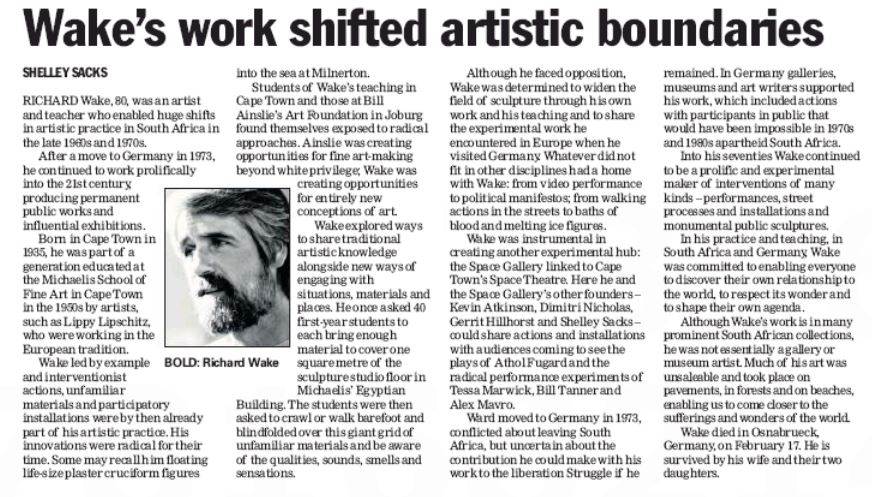Weekend Argus 03.04.2016
SHELLEY SACKS
RICHARD Wake, was an artist and teacher who enabled huge shifts in artistic practice in South Africa in the late 1960s and 1970s.
After a move to Germany in 1973 he continued to work prolifically into the 21st century producing permanent public works and influential exhibitions.
Born in Cape Town in 1935, he was part of a generation educated at the Michaelis School of Fine Art in Cape Town in the 1950s by artists such as Lippy Lipschitz, who were working in the European tradition.
Wake led by example and interventionist actions, unfamiliar materials and participatory installations were by then already part of his own artistic practice. His innovations were radical for their time. Some may recall him floating life-size plaster cruciform figures into the sea at Milnerton.
Students of Wake’s teaching in Cape Town and those at Bill Ainslie’s ‘Art Foundation’ in Johannesburg found themselves exposed to different radical approaches. Ainslie was creating opportunities for Fine Art -making beyond white privilege; Wake was creating opportunities for entirely new conceptions of art.
Wake explored ways to share traditional artistic knowledge alongside new ways of engaging with situations, materials and places. He once asked 40 first year students to each bring enough ‘material’ to cover one square meter of the sculpture studio floor in Michaelis’ ‘Eqyptian Building’. The students were then asked to crawl or walk barefoot and blindfolded over this giant grid of unfamiliar ‘materials’ and be aware of the different qualities, sounds, smells and sensations.
Although he faced opposition Richard was determined to widen the field of sculpture through his own work and his teaching and to share the experimental work he encountered in Europe when he visited Germany. Whatever did not fit in other disciplines had a home with Wake: from video performance to political manifestos; from walking actions in the streets to baths of blood and melting ice figures.
Wake was instrumental in creating another experimental hub: the Space Gallery linked to Cape Town’s Space Theatre. Here he and the Space Gallery’s other founders – Kevin Atkinson, Dimitri Nicholas, Gerrit Hillhorst and Shelley Sacks – could share actions and installations with audiences coming to see the plays of Athol Fugard and the radical performance experiments of Tessa Marwick, Bill Tanner and Alex Mavro.
Wake moved to Germany in 1973, conflicted about leaving South Africa and yet uncertain about the contribution he could make with his work to the liberation struggle if he remained. In Germany galleries, museums and art-writers supported his work, which included actions with participants in public places that would have been impossible in 1970s and 80s apartheid South Africa.
Into his seventies Richard continued to be a prolific and experimental maker of interventions of many kinds: performances, street processes and installations as well as monumental public sculptures.
In his practice and teaching, in South Africa and Germany, Richard was committed to enabling everyone to discover their own relationship to the world, to respect its wonder and to shape their own agenda.
Although Richard Wake’s work is in many prominent South African collections he was not essentially a gallery or museum artist. Much of his art was unsalable and took place on pavements, in forests, and on beaches, enabling us to come closer to the sufferings and wonders of the world.
Wake died in Osnabrueck, Germany, on February 17. He is survived by his wife and their two daughters.
